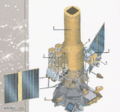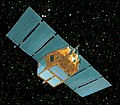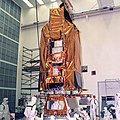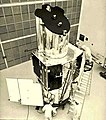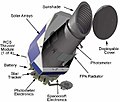List of space telescopes
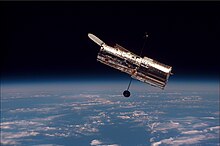
This list of space telescopes (astronomical space observatories) is grouped by major frequency ranges: gamma ray, x-ray, ultraviolet, visible, infrared, microwave and radio. Telescopes that work in multiple frequency bands are included in all of the appropriate sections. Space telescopes that collect particles, such as cosmic ray nuclei and/or electrons, as well as instruments that aim to detect gravitational waves, are also listed. Missions that look solely within our solar system, including the Earth, other planets within our system and our Sun, are excluded; see List of Solar System probes for these.
When the telescope is in Earth orbit, then two values for its height are given. These are respectively the periapsis and apoapsis of the initial orbit, i.e. the minimum and maximum distances between the telescope and the center of Earth's mass, in kilometers. Analogous values are also given when the telescope is in solar orbit, but in these cases the unit used is the astronomical unit (AU).
Gamma ray
Gamma ray telescopes collect and measure individual, high energy gamma rays from astrophysical sources. These are absorbed by the atmosphere, requiring that observations are done by high-altitude balloons or space missions. Gamma rays can be generated by supernovae, neutron stars, pulsars and black holes. Gamma ray bursts, with extremely high energies, have also been detected but have yet to be identified.[1]
-
An illustration of the Compton Gamma Ray Observatory
-
Fermi Gamma-ray Space Telescope drawing
-
An illustration of Granat
| Name | Space Agency | Launch Date | Terminated | Location | Ref(s) |
|---|---|---|---|---|---|
| 3rd High Energy Astronomy Observatory (HEAO 3) | NASA | 20 September 1979 | 29 May 1981 | Earth orbit (486.4–504.9 km) | [2][3][4] |
| Astrorivelatore Gamma ad Immagini LEggero (AGILE) | ISA | 23 April 2007 | — | Earth orbit (524–553 km) | [5][6] |
| Compton Gamma Ray Observatory (CGRO) | NASA | 5 April 1991 | 4 June 2000 | Earth orbit (362–457 km) | [7][8][9] |
| Cos-B | ESA | 9 August 1975 | 25 April 1982 | Earth orbit (339.6–99,876 km) | [10][11][12] |
| Gamma | RSA | 1 July 1990 | 1992 | Earth orbit (375 km) | [13] |
| Fermi Gamma-ray Space Telescope | NASA | 11 June 2008 | — | Earth orbit (555 km) | [14] |
| Granat | CNRS & IKI | 1 December 1989 | 25 May 1999 | Earth orbit (2,000–200,000 km) | [15][16][17] |
| High Energy Transient Explorer 2 (HETE 2) | NASA | 9 October 2000 | — | Earth orbit (590–650 km) | [18][19][20] |
| International Gamma Ray Astrophysics Laboratory (INTEGRAL) | ESA | 17 October 2002 | — | Earth orbit (639–153,000 km) | [21][22] |
| Low Energy Gamma Ray Imager (LEGRI) | INTA | 19 May 1997 | — | Earth orbit (600 km) | [23][24] |
| Second Small Astronomy Satellite (SAS 2) | NASA | 15 November 1972 | 8 June 1973 | Earth orbit (443–632 km) | [25][26] |
| Swift Gamma Ray Burst Explorer | NASA | 20 November 2004 | — | Earth orbit (585–604 km) | [27][28] |
X-ray
X-ray telescopes measure high-energy photons called X-rays. These can not travel a long distance through the atmosphere, meaning that they can only be observed high in the atmosphere or in space. Several types of astrophysical objects emit X-rays, from galaxy clusters, through black holes in active galactic nuclei to galactic objects such as supernova remnants, stars, and binary stars containing a white dwarf (cataclysmic variable stars), neutron star or black hole (X-ray binaries). Some solar system bodies emit X-rays, the most notable being the Moon, although most of the X-ray brightness of the Moon arises from reflected solar X-rays. A combination of many unresolved X-ray sources is thought to produce the observed X-ray background.
-
An artist's impression of BeppoSAX
-
The Einstein Observatory (HEAO 2)
| Name | Space Agency | Launch Date | Terminated | Location | Ref(s) |
|---|---|---|---|---|---|
| 1st High Energy Astronomy Observatory (HEAO 1) | NASA | 12 August 1977 | 9 January 1979 | Earth orbit (445 km) | [29][30][31] |
| 3rd High Energy Astronomy Observatory (HEAO 3) | NASA | 20 September 1979 | 29 May 1981 | Earth orbit (486.4–504.9 km) | [2][3][4] |
| A Broadband Imaging X-ray All-sky Survey (ABRIXAS) | DLR | 28 April 1999 | 1 July 1999 | Earth orbit (549–598 km) | [32][33][34] |
| Advanced Satellite for Cosmology and Astrophysics (ASCA) | NASA & ISAS | 20 February 1993 | 2 March 2001 | Earth orbit (523.6–615.3 km) | [35][36] |
| AGILE | ISA | 23 April 2007 | — | Earth orbit (524–553 km) | [5][6] |
| Ariel V | SRC & NASA | 15 October 1974 | 14 March 1980 | Earth orbit (520 km) | [37][38] |
| Array of Low Energy X-ray Imaging Sensors (Alexis) | LANL | 25 April 1993 | 2005 | Earth orbit (749–844 km) | [39][40][41] |
| Aryabhata | ISRO | 19 April 1975 | 23 April 1975 | Earth orbit (563–619 km) | [42] |
| Astron | IKI | 23 March 1983 | June 1989 | Earth orbit (2,000—200,000 km) | [43][44][45] |
| Astronomical Netherlands Satellite (ANS) | SRON | 30 August 1974 | June 1976 | Earth orbit (266–1176 km) | [46][47] |
| Astrosat | ISRO | April 2009 | — | Earth orbit (650 km) | [48] |
| BeppoSAX | ASI | 30 April 1996 | 30 April 2002 | Earth orbit (575–594 km) | [49][50][51] |
| Broad Band X-ray Telescope / Astro 1 | NASA | 2 December 1990 | 11 December 1990 | Earth orbit (500 km) | [52][53] |
| Chandra X-ray Observatory | NASA | 23 July 1999 | — | Earth orbit (9,942–140,000 km) | [54][55] |
| Constellation-X Observatory | NASA | TBA | — | — | [56] |
| Cos-B | ESA | 9 August 1975 | 25 April 1982 | Earth orbit (339.6–99,876 km) | [10][11][12] |
| Cosmic Radiation Satellite (CORSA) | ISAS | 6 February 1976 | 6 February 1976 | Failed launch | [57][58] |
| Dark Universe Observatory | NASA | TBA | — | Earth orbit (600 km) | [59][60] |
| Einstein Observatory (HEAO 2) | NASA | 13 November 1978 | 26 April 1981 | Earth orbit (465–476 km) | [61][62] |
| EXOSAT | ESA | 26 May 1983 | 8 April 1986 | Earth orbit (347–191,709 km) | [63][64][65] |
| Ginga (Astro-C) | ISAS | 5 February 1987 | 1 November 1991 | Earth orbit (517–708 km) | [66][67][68] |
| Granat | CNRS & IKI | 1 December 1989 | 25 May 1999 | Earth orbit (2,000–200,000 km) | [15][16][17] |
| Hakucho | ISAS | 21 February 1979 | 16 April 1985 | Earth orbit (421–433 km) | [69][70][71] |
| High Energy Transient Explorer 2 (HETE 2) | NASA | 9 October 2000 | — | Earth orbit (590–650 km) | [18][19][20] |
| International Gamma Ray Astrophysics Laboratory (INTEGRAL) | ESA | 17 October 2002 | — | Earth orbit (639–153,000 km) | [21][22] |
| Nuclear Spectroscopic Telescope Array (NuSTAR) | NASA | August 2010 | — | Earth orbit (525 km) | [72] |
| ROSAT | NASA & DLR | 1 June 1990 | 12 February 1999 | Earth orbit (580 km) | [73][74][75] |
| Rossi X-ray Timing Explorer | NASA | 30 December 1995 | — | Earth orbit (409 km) | [76][77] |
| Spectrum-X-Gamma | IKI & NASA | 2010 | — | — | [78] |
| Suzaku (ASTRO-E2) | JAXA & NASA | 10 July 2005 | — | Earth orbit (550 km) | [79][80] |
| Swift Gamma Ray Burst Explorer | NASA | 20 November 2004 | — | Earth orbit (585–604 km) | [27][28] |
| Tenma | ISAS | 20 February 1983 | 19 January 1989 | Earth orbit (489–503 km) | [81][82][83] |
| Third Small Astronomy Satellite (SAS-C) | NASA | 7 May 1975 | April 1979 | Earth orbit (509–516 km) | [84][85][86] |
| Uhuru | NASA | 12 December 1970 | March 1973 | Earth orbit (531–572 km) | [87][88][89] |
| X-Ray Evolving Universe Spectroscopy Mission (XEUS) | ESA | 2018 | — | — | [90] |
| XMM-Newton | ESA | 10 December 1999 | — | Earth orbit (7,365–114,000 km) | [91][92] |
Ultraviolet
Ultraviolet telescopes make observations at ultraviolet wavelengths, i.e. between approximately 100 and 3200 Å. Light at these wavelengths is absorbed by the Earth's atmosphere, so observations at these wavelengths must be performed from the upper atmosphere or from space.[93] Objects emitting ultraviolet radiation include the Sun, other stars and galaxies.[94]
-
An artist's impression of GALEX
-
The Copernicus Observatory in a clean room
| Name | Space Agency | Launch Date | Terminated | Location | Ref(s) |
|---|---|---|---|---|---|
| Astro 2 | NASA | 2 March 1993 | 18 March 1993 | Earth orbit (349–363 km) | [95][96] |
| Astron | IKI | 23 March 1983 | June 1989 | Earth orbit (2,000–200,000 km) | [43][44][45] |
| Astronomical Netherlands Satellite (ANS) | SRON | 30 August 1974 | June 1976 | Earth orbit (266–1176 km) | [46][47] |
| Astrosat | ISRO | April 2009 | — | Earth orbit (650 km) | [48] |
| Broad Band X-ray Telescope / Astro 1 | NASA | 2 December 1990 | 11 December 1990 | Earth orbit (500 km) | [52][53] |
| Copernicus Observatory | NASA | 21 August 1972 | 1980 | Earth orbit (713–724 km) | [97] |
| Cosmic Hot Interstellar Spectrometer (CHIPS) | NASA | 13 January 2003 | — | Earth orbit (578–594 km) | [98][99] |
| Extreme Ultraviolet Explorer (EUVE) | NASA | 7 June 1992 | 30 January 2002 | Earth orbit (515–527 km) | [100][101] |
| Far Ultraviolet Spectroscopic Explorer (FUSE) | NASA & CNES & CSA | 24 June 1999 | 12 July 2007 | Earth orbit (752–767 km) | [102][103] |
| Galaxy Evolution Explorer (GALEX) | NASA | 28 April 2003 | — | Earth orbit (691–697 km) | [104][105] |
| Hubble Space Telescope | NASA | 24 April 1990 | — | Earth orbit (586.47–610.44 km) | [106] |
| International Ultraviolet Explorer (IUE) | ESA & NASA & SERC | 26 January 1978 | 30 September 1996 | Earth orbit (32,050–52,254 km) | [107][108] |
| Korea Advanced Institute of Science and Technology Satellite 4 (Kaistsat 4) | KARI | 27 September 2003 | — | Earth orbit (675–695 km) | [109][110] |
| OAO-2 | NASA | 7 December 1968 | January 1973 | Earth orbit (749–758 km) | [111][97] |
| Swift Gamma Ray Burst Explorer | NASA | 20 November 2004 | — | Earth orbit (585–604 km) | [27][28] |
| Tel Aviv University Ultraviolet Explorer (TAUVEX) | Israeli Space Agency | October 2009 | — | — | [112] |
Visible
The oldest form of astronomy, optical or visible-light astronomy extends from approximately 4000 Å to 7000 Å (400 nm to 700 nm).[113]. Positioning an optical telescope in space means that the telescope does not see any atmospheric effects (see astronomical seeing), providing higher resolution images. Optical telescopes are used to look at stars, galaxies, planetary nebulae and protoplanetary disks, amongst many other things.[114]
-
Artist's impression of Hipparcos
-
Concept drawing of the Kepler Mission
-
Artist's impression of the SIM Lite Astrometric Observatory
| Name | Space Agency | Launch Date | Terminated | Location | Ref(s) |
|---|---|---|---|---|---|
| Astrosat | ISRO | April 2009 | — | Earth orbit (650 km) | [48] |
| COROT | CNES & ESA | 27 December 2006 | — | Earth orbit (872–884 km) | [115][116] |
| Dark Energy Space Telescope | NASA & DOE | TBA | — | — | [117] |
| Gaia mission | ESA | 2011 | — | Lagrangian 2 point | [118] |
| Hipparcos | ESA | 8 August 1989 | March 1993 | Earth orbit (223–35,632 km) | [119][120][121] |
| Hubble Space Telescope | NASA | 24 April 1990 | — | Earth orbit (586.47–610.44 km) | [106] |
| Kepler Mission | NASA | 6 March 2009 | — | Earth-trailing heliocentric orbit | [122][123][124] |
| MOST | CSA | 30 June 2003 | — | Earth orbit (819–832 km) | [125][126] |
| SIM Lite Astrometric Observatory | NASA | 2015 | — | — | [127] |
| Swift Gamma Ray Burst Explorer | NASA | 20 November 2004 | — | Earth orbit (585–604 km) | [27][28] |
| Terrestrial Planet Finder | NASA | TBA | — | — | [128] |
Infrared
Infrared light is of lower energy than visible light, hence is emitted by cooler objects. As such, the following can be viewed in the infrared: cool stars (including brown dwarves), nebulae, and redshifted galaxies.[129]
-
Artist's impression of the Herschel Space Observatory
-
Artist's impression of IRAS
-
Artist's impression of the James Webb Space Telescope
| Name | Space Agency | Launch Date | Terminated | Location | Ref(s) |
|---|---|---|---|---|---|
| AKARI | JAXA | February 21, 2006 | — | Earth orbit (586.47–610.44 km) | [130][131] |
| Darwin Mission | ESA | 2015 | — | Lagrangian 2 point | [132] |
| Herschel Space Observatory | ESA & NASA | 14 May 2009 [133] | — | Lagrangian 2 point | [134][135][136] |
| IRAS | NASA | 25 January 1983 | 21 November 1983 | Earth orbit (889–903 km) | [137][138] |
| Infrared Space Observatory (ISO) | ESA | 17 November 1995 | 16 May 1998 | Earth orbit (1000–70500 km) | [139][139][140] |
| Infrared Telescope in Space | ISAS & NASDA | 18 March 1995 | 25 April 1995 | Earth orbit (486 km) | [141][142] |
| James Webb Space Telescope | NASA | 2013 | — | — | [143] |
| Midcourse Space Experiment (MSX) | USN | 24 April 1996 | 26 February 1997 | Earth orbit (900 km) | [144] |
| Spitzer Space Telescope | NASA | 25 August 2003 | — | Solar orbit (0.98–1.02 AU) | [145][146] |
| Submillimeter Wave Astronomy Satellite (SWAS) | NASA | 6 December 1998 | — | Earth orbit (638–651 km) | [147][148] |
| Terrestrial Planet Finder | NASA | TBA | — | — | [128] |
| Wide-field Infrared Explorer (WIRE) | NASA | 5 March 1999 | — | — | [149] |
| Wide-field Infrared Survey Explorer (WISE) | NASA | 2009 | — | Earth orbit (500 km) | [150][151] |
Microwave
At microwave frequencies, photons are plentiful, but they have very low energy so lots of them need to be collected. At these frequencies, the Cosmic Microwave Background can be measured, as well as point sources and the Sunyaev-Zel'dovich effect, as well as synchrotron radiation and Bremsstrahlung from our own galaxy.
-
Artist's impression of Planck satellite
-
Artist's impression of WMAP
| Name | Space Agency | Launch Date | Terminated | Location | Ref(s) |
|---|---|---|---|---|---|
| Cosmic Background Explorer (COBE) | NASA | 18 November 1989 | 23 December 1993 | Earth orbit (900 km) | [152][153] |
| Odin | Swedish Space Corporation | 20 February 2001 | — | Earth orbit (622 km) | [154][155] |
| Planck satellite | ESA | 14 May 2009 | — | Lagrangian 2 point | [156][157][135] |
| WMAP | NASA | 30 June 2001 | — | Lagrangian 2 point | [158] |
Radio
As the atmosphere is transparent for radio waves, radio telescopes in space are of most use for Very Long Baseline Interferometry; doing simultaneous observations of a source with both a satellite and a ground-based telescope and by correlating their signals to simulate a radio telescope the size of the separation between the two telescopes. Observations can be of supernova remnants, masers, gravitational lenses, starburst galaxies, and many other things.
| Name | Space Agency | Launch Date | Terminated | Location | Ref(s) |
|---|---|---|---|---|---|
| Highly Advanced Laboratory for Communications and Astronomy (HALCA, or VSOP) | ISAS | 12 February 1997 | 30 November 2005 | Earth orbit (560–21,400 km) | [159][160][161] |
| RadioAstron | IKI | October 2008 | — | Earth orbit (10,000–390,000 km) | [162][163] |
| VSOP-2 | JAXA | 2012 | — | — | [164] |
Particle detection
Satellites that do particle detection look for cosmic rays and electrons. These can be emitted by the sun (Solar Energetic Particles), our galaxy (Galactic cosmic rays) and extragalactic sources (Extragalactic cosmic rays). There are also Ultra-high-energy cosmic rays from active galactic nuclei.
| Name | Space Agency | Launch Date | Terminated | Location | Ref(s) |
|---|---|---|---|---|---|
| 3rd High Energy Astrophysics Observatory (HEAO 3) | NASA | 20 September 1979 | 29 May 1981 | Earth orbit (486.4–504.9 km) | [2][3][3] |
| Astromag Free-Flyer | NASA | 1 January 2005 | — | Earth orbit (500 km) | [165][166] |
| Payload for Antimatter Matter Exploration and Light-nuclei Astrophysics (PAMELA) | ISA, INFN, RSA, DLR & SNSB | 15 May 2006 | — | Earth orbit (350–610 km) | [167][168] |
Gravitational waves
A proposed new type of telescope is one that detects gravitational waves; ripples in space-time generated by colliding neutron stars and black holes.
-
Artist's impression of the Laser Interferometer Space Antenna
| Name | Space Agency | Launch Date | Terminated | Location | Ref(s) |
|---|---|---|---|---|---|
| Laser Interferometer Space Antenna (LISA) | NASA | 2018 | — | Solar orbit (approx. 1 AU; trailing Earth) | [169] |
References
- ^ "Gamma rays". NASA. Retrieved 2008-03-01.
- ^ a b c "NASA - NSSD - Spacecraft - Trajectory Details (HEAO 3)". NASA. Retrieved 2008-02-27.
- ^ a b c d "NASA - NSSDC - Spacecraft - Details (HEAO 3)". NASA. Retrieved 2008-02-27. Cite error: The named reference "heao3_2" was defined multiple times with different content (see the help page).
- ^ a b "The High Energy Astrophysics Observatory-3 (HEAO-3)". NASA. 26 June 2003. Retrieved 2008-02-27.
- ^ a b "NASA - NSSD - Spacecraft - Trajectory Details (AGILE)". NASA. Retrieved 2008-02-27.
- ^ a b "NASA - NSSDC - Spacecraft - Details (AGILE)". NASA. Retrieved 2008-02-27.
- ^ "NASA - NSSD - Spacecraft - Trajectory Details (Compton Gamma Ray Observatory)". NASA. Retrieved 2008-02-27.
- ^ "NASA - NSSDC - Spacecraft - Details (Compton Gamma Ray Observatory)". NASA. Retrieved 2008-02-27.
- ^ "CGRO Science Support Center". NASA. Retrieved 2008-02-27.
- ^ a b "NASA - NSSD - Spacecraft - Trajectory Details (COS-B)". NASA. Retrieved 2008-02-27.
- ^ a b "NASA - NSSDC - Spacecraft - Details (COS-B)". NASA. Retrieved 2008-02-27.
- ^ a b "ESA - Space Science - Cos-B overview". ESA. Retrieved 2008-02-28. Cite error: The named reference "cosb3" was defined multiple times with different content (see the help page).
- ^ "The Gamma Satellite". NASA. Retrieved 2008-02-29.
- ^ "GLAST Overview - The GLAST Mission". NASA. 19 December 2007. Retrieved 2008-02-27.
- ^ a b "NASA - NSSD - Spacecraft - Trajectory Details (GRANAT)". NASA. Retrieved 2008-02-27.
- ^ a b "NASA - NSSDC - Spacecraft - Details (GRANAT)". NASA. Retrieved 2008-02-27.
- ^ a b "1999 Reentries" (PDF). The Aerospace Corporation, Center for Orbital and Reentry Debris Studies. Retrieved 2008-02-26.
- ^ a b "NASA - NSSD - Spacecraft - Trajectory Details (HETE 2)". NASA. Retrieved 2008-02-27.
- ^ a b "NASA - NSSDC - Spacecraft - Details (HETE 2)". NASA. Retrieved 2008-02-27.
- ^ a b "The High Energy Transient Explorer (HETE-2)". Massachusetts Institute of Technology. 28 March 2007. Retrieved 2008-02-27. Cite error: The named reference "hete2_3" was defined multiple times with different content (see the help page).
- ^ a b "NASA - NSSD - Spacecraft - Trajectory Details (INTEGRAL)". NASA. Retrieved 2008-02-27.
- ^ a b "NASA - NSSDC - Spacecraft - Details (INTEGRAL)". NASA. Retrieved 2008-02-27.
- ^ "Instrumentation: Low Energy Gamma Ray Imager (LEGRI)". Birmingham University. 24 January 2006. Retrieved 2008-02-27.
{{cite web}}: Cite has empty unknown parameter:|1=(help) - ^ "LEGRI". NASA. 4 December 1997. Retrieved 2008-02-28.
- ^ "NASA - NSSD - Spacecraft - Trajectory Details (SAS-B)". NASA. Retrieved 2008-02-27.
- ^ "NASA - NSSDC - Spacecraft - Details (SAS-B)". NASA. Retrieved 2008-02-27.
- ^ a b c d "NASA - NSSD - Spacecraft - Trajectory Details (Swift)". NASA. Retrieved 2008-02-27.
- ^ a b c d "NASA - NSSDC - Spacecraft - Details (Swift)". NASA. Retrieved 2008-02-27.
- ^ "NASA - NSSDC - Spacecraft - Details (HEAO 1)". NASA. Retrieved 2008-02-27.
- ^ "The High Energy Astrophysics Observatory-1 - Overview". NASA. Retrieved 2008-02-28.
- ^ "The High Energy Astrophysics Observatory-1 - Mission Overview". NASA. Retrieved 2008-02-28.
- ^ "NASA - NSSD - Spacecraft - Trajectory Details (ABRIXAS)". NASA. Retrieved 2008-02-27.
- ^ "NASA - NSSDC - Spacecraft - Details (ABRIXAS)". NASA. Retrieved 2008-02-27.
- ^ "ABRIXAS". Astronautix.com. Retrieved 2008-02-28.
- ^ "NASA - NSSD - Spacecraft - Trajectory Details (ASCA)". NASA. Retrieved 2008-02-27.
- ^ "NASA - NSSDC - Spacecraft - Details (ASCA)". NASA. Retrieved 2008-02-27.
- ^ "The Ariel V Satellite". NASA. Retrieved 2008-02-29.
- ^ "The Ariel V Satellite - About". NASA. Retrieved 2008-02-29.
- ^ "NASA - NSSD - Spacecraft - Trajectory Details (Alexis)". NASA. Retrieved 2008-02-27.
- ^ "NASA - NSSDC - Spacecraft - Details (Alexis)". NASA. Retrieved 2008-02-27.
- ^ "AeroAstro Returning to Space With Launch of STPSat-1 This Fall". Space.com. 5 June 2006. Retrieved 2008-02-28.
- ^ "The Aryabhata Satellite". NASA. Retrieved 2008-02-29.
- ^ a b "NASA - NSSD - Spacecraft - Trajectory Details (ASTRON)". NASA. Retrieved 2008-02-27.
- ^ a b "NASA - NSSDC - Spacecraft - Details (ASTRON)". NASA. Retrieved 2008-02-27.
- ^ a b "The Astron Satellite". NASA. Retrieved 2008-02-28.
- ^ a b "NASA - NSSD - Spacecraft - Trajectory Details (ANS)". NASA. Retrieved 2008-02-27.
- ^ a b "NASA - NSSDC - Spacecraft - Details (ANS)". NASA. Retrieved 2008-02-27.
- ^ a b c "ASTROSAT - An Indian Multiwave Astronomy Satellite". Inter-University Centre for Astronomy and Astrophysics. Retrieved 2008-02-28.
- ^ "NASA - NSSD - Spacecraft - Trajectory Details (BeppoSAX)". NASA. Retrieved 2008-02-27.
- ^ "NASA - NSSDC - Spacecraft - Details (BeppoSAX)". NASA. Retrieved 2008-02-27.
- ^ "HEASARC: BeppoSAX Guest Observer Facility". NASA. Retrieved 2008-02-28.
- ^ a b "NASA - NSSD - Spacecraft - Trajectory Details (Astro 1)". NASA. Retrieved 2008-02-27.
- ^ a b "NASA - NSSDC - Spacecraft - Details (Astro 1)". NASA. Retrieved 2008-02-27.
- ^ "NASA - NSSD - Spacecraft - Trajectory Details (Chandra)". NASA. Retrieved 2008-02-27.
- ^ "NASA - NSSDC - Spacecraft - Details (Chandra)". NASA. Retrieved 2008-02-27.
- ^ "Official NASA Constellation-X Home Page". NASA. Retrieved 2008-02-28.
- ^ "NASA - NSSD - Spacecraft - Trajectory Details (CORSA)". NASA. Retrieved 2008-02-27.
- ^ "NASA - NSSDC - Spacecraft - Details (CORSA)". NASA. Retrieved 2008-02-27.
- ^ "Dark Universe Observatory". Sonoma State University. Retrieved 2008-02-29.
- ^ "Dark Universe Observatory - About the Launch Vehicle and Orbit". Sonoma State University. Retrieved 2008-02-29.
- ^ "NASA - NSSD - Spacecraft - Trajectory Details (Einstein Observatory)". NASA. Retrieved 2008-02-27.
- ^ "NASA - NSSDC - Spacecraft - Details (Einstein Observatory)". NASA. Retrieved 2008-02-27.
- ^ "NASA - NSSD - Spacecraft - Trajectory Details (Exosat)". NASA. Retrieved 2008-02-27.
- ^ "NASA - NSSDC - Spacecraft - Details (Exosat)". NASA. Retrieved 2008-02-27.
- ^ "ESA Science & Technology: Exosat". ESA. Retrieved 2008-02-28.
- ^ "NASA - NSSD - Spacecraft - Trajectory Details (Astro-C)". NASA. Retrieved 2008-02-27.
- ^ "NASA - NSSDC - Spacecraft - Details (Astro-C)". NASA. Retrieved 2008-02-27.
- ^ "The Ginga Observatory". NASA. Retrieved 2008-02-28.
- ^ "NASA - NSSD - Spacecraft - Trajectory Details (Hakucho)". NASA. Retrieved 2008-02-27.
- ^ "NASA - NSSDC - Spacecraft - Details (Hakucho)". NASA. Retrieved 2008-02-27.
- ^ "The Hakucho (CORSA-B) Satellite". NASA. Retrieved 2008-02-28.
- ^ "NuSTAR Quickfacts". California Institute of Technology. Retrieved 2008-02-28.
- ^ "NASA - NSSD - Spacecraft - Trajectory Details (ROSAT)". NASA. Retrieved 2008-02-27.
- ^ "NASA - NSSDC - Spacecraft - Details (ROSAT)". NASA. Retrieved 2008-02-27.
- ^ "The Roentgen Satellite". NASA. Retrieved 2008-02-28.
- ^ "NASA - NSSD - Spacecraft - Trajectory Details (X-Ray Timing Explorer)". NASA. Retrieved 2008-02-27.
- ^ "NASA - NSSDC - Spacecraft - Details (X-Ray Timing Explorer)". NASA. Retrieved 2008-02-27.
- ^ "NASA - NSSDC - Spacecraft - Details (Spectrum-X-Gamma)". NASA. Retrieved 2008-02-27.
- ^ "NASA - NSSD - Spacecraft - Trajectory Details (Suzaku)". NASA. Retrieved 2008-02-27.
- ^ "NASA - NSSDC - Spacecraft - Details (Suzaku)". NASA. Retrieved 2008-02-27.
- ^ "NASA - NSSD - Spacecraft - Trajectory Details (Tenma)". NASA. Retrieved 2008-02-27.
- ^ "NASA - NSSDC - Spacecraft - Details (Tenma)". NASA. Retrieved 2008-02-27.
- ^ "Institute of Space and Astronautical Science - JAXA - Tenma". JAXA. Retrieved 2008-02-28.
- ^ "NASA - NSSD - Spacecraft - Trajectory Details (SAS-C)". NASA. Retrieved 2008-02-27.
- ^ "NASA - NSSDC - Spacecraft - Details (SAS-C)". NASA. Retrieved 2008-02-27.
- ^ "The Third Small Astronomy Satellite (SAS-3)". NASA. Retrieved 2008-02-28.
- ^ "NASA - NSSD - Spacecraft - Trajectory Details (Uhuru)". NASA. Retrieved 2008-02-27.
- ^ "NASA - NSSDC - Spacecraft - Details (Uhuru)". NASA. Retrieved 2008-02-27.
- ^ "The Uhuru Satellite". NASA. Retrieved 2008-02-28.
- ^ "KEUS - The X-Ray Evolving Universe Spectroscopy Mission". ESA. Retrieved 2008-02-28.
- ^ "NASA - NSSD - Spacecraft - Trajectory Details (XMM-Newton)". NASA. Retrieved 2008-02-25.
- ^ "NASA - NSSDC - Spacecraft - Details (XMM-Newton)". NASA. Retrieved 2008-02-25.
- ^ A. N. Cox, editor (2000). Allen's Astrophysical Quantities. New York: Springer-Verlag. ISBN 0-387-98746-0.
{{cite book}}:|author=has generic name (help) - ^ "Ultraviolet Waves". NASA. Retrieved 2008-02-28.
- ^ "NASA - NSSD - Spacecraft - Trajectory Details (Astro 2)". NASA. Retrieved 2008-02-27.
- ^ "NASA - NSSDC - Spacecraft - Details (Astro 2)". NASA. Retrieved 2008-02-27.
- ^ a b Darling, David. "Orbiting Astronomical Observatory (OAO) in the Internet Encyclopedia of Science". Retrieved 2008-02-28.
- ^ "NASA - NSSD - Spacecraft - Trajectory Details (CHIPS)". NASA. Retrieved 2008-02-27.
- ^ "NASA - NSSDC - Spacecraft - Details (CHIPS)". NASA. Retrieved 2008-02-27.
- ^ "NASA - NSSD - Spacecraft - Trajectory Details (EUVE)". NASA. Retrieved 2008-02-27.
- ^ "NASA - NSSDC - Spacecraft - Details (EUVE)". NASA. Retrieved 2008-02-27.
- ^ "NASA - NSSD - Spacecraft - Trajectory Details (FUSE)". NASA. Retrieved 2008-02-27.
- ^ "NASA - NSSDC - Spacecraft - Details (FUSE)". NASA. Retrieved 2008-02-27.
- ^ "NASA - NSSD - Spacecraft - Trajectory Details (GALEX)". NASA. Retrieved 2008-02-27.
- ^ "NASA - NSSDC - Spacecraft - Details (GALEX)". NASA. Retrieved 2008-02-27.
- ^ a b "NASA - NSSD - Spacecraft - Trajectory Details (Hubble Space Telescope)". NASA. Retrieved 2008-02-27.
- ^ "ESA Science & Technology: IUE". ESA. Retrieved 2008-02-29.
- ^ "NASA - NSSDC - Spacecraft - Details (IUE)". NASA. Retrieved 2008-02-27.
- ^ "NASA - NSSD - Spacecraft - Trajectory Details (Kaistsat 4)". NASA. Retrieved 2008-02-27.
- ^ "NASA - NSSDC - Spacecraft - Details (Kaistsat 4)". NASA. Retrieved 2008-02-27.
- ^ "Orbiting Astronomical Observatory OAO-2". University of Wisconsin-Madison. Retrieved 2008-02-28.
- ^ "TAUVEX: UV Astronomy Mission". Indian Institute of Astronomy. Retrieved 2008-02-28.
- ^ P. Moore (1997). Philip's Atlas of the Universe. Great Britain: George Philis Limited. ISBN 0-540-07465-9.
- ^ "HubbleSite - The Telescope - Hubble Essentials". NASA. Retrieved 2008-03-01.
{{cite web}}: Text "urlhttp://hubblesite.org/the_telescope/hubble_essentials/" ignored (help) - ^ "NASA - NSSD - Spacecraft - Trajectory Details (COROT)". NASA. Retrieved 2008-02-27.
- ^ "NASA - NSSDC - Spacecraft - Details (COROT)". NASA. Retrieved 2008-02-27.
- ^ "Destiny JDEM Mission Public Page". National Optical Astronomy Observatory. Retrieved 2008-02-28.
- ^ "ESA - Space Science - Gaia overview". ESA. Retrieved 2008-02-28.
- ^ "NASA - NSSD - Spacecraft - Trajectory Details (Hipparcus)". NASA. Retrieved 2008-02-27.
- ^ "NASA - NSSDC - Spacecraft - Details (Hipparcus)". NASA. Retrieved 2008-02-27.
- ^ "The Hipparcos Space Astrometry Mission". ESA. Retrieved 2008-02-28.
- ^ Staff writers (7 March 2009). "Nasa launches Earth hunter probe". BBC News. Retrieved 2009-03-14.
- ^ "Kepler Mission". NASA. Retrieved 2008-02-28.
- ^ "Kepler - About - Mission News". NASA. Retrieved 2008-02-28.
- ^ "NASA - NSSD - Spacecraft - Trajectory Details (MOST)". NASA. Retrieved 2008-02-27.
- ^ "NASA - NSSDC - Spacecraft - Details (MOST)". NASA. Retrieved 2008-02-27.
- ^ "SIM Lite JPL". NASA. Retrieved 2009-03-19.
- ^ a b "Planet Quest: Missions - Terrestrial Planet Finder". NASA. Retrieved 2008-03-03.
- ^ "Cool Cosmos". California Institute of Technology. Retrieved 2008-03-01.
- ^ "NASA - NSSD - Spacecraft - Trajectory Details (Akari)". NASA. Retrieved 2008-02-27.
- ^ "NASA - NSSDC - Spacecraft - Details (Akari)". NASA. Retrieved 2008-02-27.
- ^ "ESA Science & Technology: Darwin". ESA. Retrieved 2008-02-28.
- ^ "Jet Propulsion Laboratory Herschel Mission News". Herschel.jpl.nasa.gov. Retrieved 2009-08-19.
- ^ "NASA - NSSDC - Spacecraft - Details (Herschel Space Observatory)". NASA. Retrieved 2008-02-27.
- ^ a b "Planck - Home Page". ESA. 6 March 2008. Retrieved 2008-03-15. Cite error: The named reference "planck_homepage" was defined multiple times with different content (see the help page).
- ^ "Herschel Science Centre - A short Herschel mission overview". ESA. 20 November 2007. Retrieved 2008-03-15.
- ^ "NASA - NSSD - Spacecraft - Trajectory Details (IRAS)". NASA. Retrieved 2008-02-27.
- ^ "NASA - NSSDC - Spacecraft - Details (IRAS)". NASA. Retrieved 2008-02-27.
- ^ a b "NASA - NSSD - Spacecraft - Trajectory Details (ISO)". NASA. Retrieved 2008-02-27. Cite error: The named reference "iso" was defined multiple times with different content (see the help page).
- ^ "ESA Science & Technology: ISO". ESA. Retrieved 2008-02-28.
- ^ "IRTS Home Page". Institute of Space and Astronautical Science. Retrieved 2008-02-29.
- ^ Murakami, Hiroshi. "The IRTS (Infrared Telescope in Space) Mission". Publications of the Astronomical Society of Japan. 48: L41 – L46.
{{cite journal}}: Unknown parameter|coauthors=ignored (|author=suggested) (help) - ^ "The James Webb Space Telescope". NASA. Retrieved 2008-02-28.
- ^ "MSX Project Page". Infrared Processing and Analysis Center. Retrieved 2008-02-29.
- ^ "NASA - NSSD - Spacecraft - Trajectory Details (Spitzer)". NASA. Retrieved 2008-02-27.
- ^ "NASA - NSSDC - Spacecraft - Details (Spitzer)". NASA. Retrieved 2008-02-27.
- ^ "NASA - NSSD - Spacecraft - Trajectory Details (SWAS)". NASA. Retrieved 2008-02-27.
- ^ "NASA - NSSDC - Spacecraft - Details (SWAS)". NASA. Retrieved 2008-02-27.
- ^ "NASA - NSSDC - Spacecraft - Details (WIRE)". NASA. Retrieved 2008-02-27.
- ^ "WISE: Wide-Field Infrared Survey Explorer". University of California, Los Angeles. Retrieved 2008-03-03.
- ^ "WISE - Mapping the Infrared Sky" (PDF). NASA. Retrieved 2008-03-03.
- ^ "NASA - NSSD - Spacecraft - Trajectory Details (COBE)". NASA. Retrieved 2008-02-27.
- ^ "NASA - NSSDC - Spacecraft - Details (COBE)". NASA. Retrieved 2008-02-27.
- ^ "NASA - NSSD - Spacecraft - Trajectory Details (Odin)". NASA. Retrieved 2008-02-27.
- ^ "NASA - NSSDC - Spacecraft - Details (Odin)". NASA. Retrieved 2008-02-27.
- ^ "NASA - NSSDC - Spacecraft - Details (PLANCK)". NASA. Retrieved 2008-02-27.
- ^ "Planck - Home Page". ESA. Retrieved 2008-02-28.
- ^ "NASA - NSSDC - Spacecraft - Details (WMAP)". NASA. Retrieved 2008-02-27.
- ^ "NASA - NSSD - Spacecraft - Trajectory Details (HALCA)". NASA. Retrieved 2008-02-27.
- ^ "NASA - NSSDC - Spacecraft - Details (HALCA)". NASA. Retrieved 2008-02-27.
- ^ "Minutes of VSOP-2 Tracking Station Meeting, 10/31-11/01/06" (PDF). National Astronomical Observatory of Japan. Retrieved 2008-02-28.
- ^ "Description of the RadioAstron project". Russian Space Research Institute. Retrieved 2008-02-28.
- ^ "Description of the RadioAstron project - Orbit". Russian Space Research Institute. Retrieved 2008-02-28.
- ^ "VSOP-2 project". JAXA. Retrieved 2008-02-28.
- ^ "NASA - NSSD - Spacecraft - Trajectory Details (Astromag FF)". NASA. Retrieved 2008-02-27.
- ^ "NASA - NSSDC - Spacecraft - Details (Astromag-F)". NASA. Retrieved 2008-02-27.
- ^ "PAMELA Mission Official Website". Istituto Nazionale di Fisica Nucleare. Retrieved 2008-03-09.
- ^ "PAMELA Mission Official Website - Partners". Istituto Nazionale di Fisica Nucleare. Retrieved 2008-03-09.
- ^ "ESA Science & Technology: LISA". ESA. Retrieved 2008-02-27.


